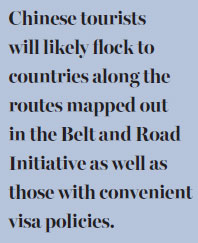No slowing down for outbound tours

Lifting of visa restrictions, urbanization among the many reasons more Chinese are traveling abroad in bigger numbers
China's outbound tourism market is expected to sustain rapid growth this year thanks to multiple favorable elements at home and abroad. The number of outbound tourists is expected to surpass 130 million in 2016, up 10 percent over 2015.
China's supply-side reform, which aims to improve industrial efficiency and productivity and reduce corporate costs through tax cuts and other measures, will produce new engines for economic growth, which is good news for outbound tourism.
Efforts to ensure the orderly development of the sector will continue, as China considers tourism an integral part of social harmony. As President Xi Jinping has pointed out, tourism is seen as an important barometer of the standard of living, while outbound tourism holds a special charm for the Chinese.
Developed economies are paying more attention to the role of inbound tourism in boosting local economies and employment. Hence, neighboring, medium-distance and long-distance destinations will continue to compete for Chinese tourists. The relaxed visa policies and improved Chinese-language services that nations have introduced in recent years are proof of that.
The exchange rate for China's currency, the renminbi, is likely to maintain a downward trend this year, according to multiple financial institutes, but the range won't be too wide or halt momentum in China's outbound tourism.
Chinese tourists will likely flock to countries along the routes mapped out in the Belt and Road Initiative as well as those with convenient visa policies.

Since mid-2014, the State Council has made clear that it wants to develop tourism along the Belt and Road routes, which will link Asia with the Middle East, Africa and Europe, while the country has been actively working with other countries and regions to make this a reality. China has held or plans to hold major tourism programs with South Korea, India and countries in Central and Eastern Europe.
In its 2014 report on the impact of tourism on the global economy, the World Travel and Tourism Council, headquartered in London, said visa policy restrictions were one of the main obstacles to tourism market growth. To prove the point, visits by Chinese have swelled in countries that have waived visas, introduced visas on arrival, streamlined application procedures or cut processing costs.
Chinese visitors to South Korea's Jeju Island surged by 58 percent year-on-year to nearly 2.9 million in 2014 after the authorities there started to allow 30-day visa-free stays. The flow of Chinese tourists will therefore likely grow thanks to further loosened visa policies this year.
More outbound tourists are likely to emerge from China's central and western regions, especially from second- or third-tier cities and rural areas.
According to forecasts by the Ministry of Transportation, the country was to have 42 high-speed railways in operation by the end of 2015, stretching a total of 20,000 kilometers. The rapid development of high-speed rail gives people from once-isolated areas easy access to large cities, which will greatly broaden the source of outbound Chinese tourists.
Urbanization will also continue to power growth in tourism consumption. Data from the National Bureau of Statistics suggested the urbanization rate would reach 58 percent in 2015. Mid sized and small cities and rural areas are already warming to the outbound tourism market.
Meanwhile, retail consumption will likely flow back to China in 2016. Cross-border e-commerce businesses have enjoyed booming growth thanks in part to the development of free trade zones and favorable policies, which will be further stepped up in the new year.
Chinese are expected to buy more in their homeland as more foreign goods become available, while there is also room to cut prices and improve after-sales services.
The author is director of the China Tourism Academy's International Tourism
Development Institute. The views do not necessarily reflect those of China Daily.
(China Daily European Weekly 01/08/2016 page9)
Today's Top News
- New engine powers cargo drone expansion
- China to boost intl cooperation on green tech
- Factory activity sees marginal improvement in November
- Venezuela slams US' 'colonial threat' on its airspace
- Xi: Strengthen cyberspace governance framework
- Takaichi must stop rubbing salt in wounds, retract Taiwan remarks






























